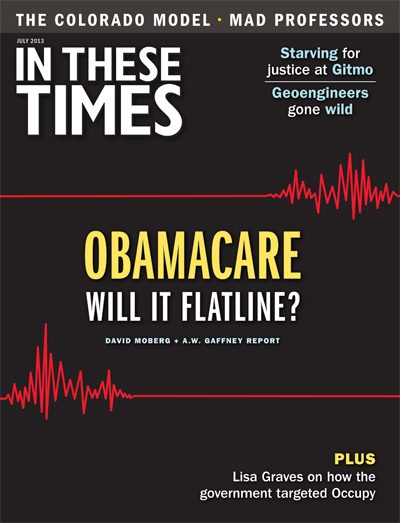Underinsured in the Age of Obamacare
The Affordable Care Act does not make healthcare a right.
Adam Gaffney

During the second presidential debate of 2008, Tom Brokaw asked Barack Obama and John McCain: “Is healthcare in America a privilege, a right or a responsibility?”
Obama, unlike McCain, did not hesitate to respond plainly that healthcare “should be a right for every American.” He proceeded to make healthcare reform a major goal of his presidency.
Sadly, though, whatever its merits (and they are substantial), the Affordable Care Act (ACA) will not create a right to healthcare in America. Nor will it lead to a system of universal healthcare. Not because it will leave millions uninsured — though it will do that — for if uninsurance were the law’s only flaw, with some combination of an expansion of subsidies and of Medicaid, the ACA could be transformed into a truly universal system. The law has a more fundamental flaw: It fails to reverse a peculiarly American trend toward what is euphemistically called “underinsurance.” We may have health insurance, in other words, but we cannot afford to become ill.
The ACA may actually exacerbate a practice that many of us face, in a limited and innocuous way, in our encounters with the healthcare system — a practice known as “cost-sharing.”
Cost-sharing takes the form of co-pays, deductibles and other payments that are not covered by insurance and are often exacted at the point of service. In theory, cost-sharing decreases medical spending by giving us “skin in the game,” as commentators frequently (and oddly) put it. The theory is that by forcing us to pay something out-of-pocket every time we “consume” healthcare, we are disincentived to utilize in excess, hence medical spending is controlled.
Many would ask whether the average person really needs to be disincentived from an invasive procedure or an unnecessary afternoon in the doctor’s office. But in any event, it is clear that as cost-sharing eats up larger portions of our disposable income, we become “underinsured,” forced to go broke or ration our healthcare.
Evidence suggests that underinsurance has been on the rise for years. A study published in the journal Health Affairs in 2008 found that in 2007, about 20 percent of Americans with insurance age 19-64 — about 25 million individuals — could be classified as underinsured (defined as having an exposure to out-of-pocket expenses above a certain threshold). This represents a striking 60 percent increase since 2003. Along similar lines, according to a report from the Kaiser Family Foundation, the percentage of insured workers with a deductible of $1,000 or more increased from 10 percent in 2006 to 34 percent in 2012, while the percent with a deductible of $2,000 or more increased from 3 percent to 14 percent.
But more telling than these figures is what underinsurance means to those who must live with it day after day. In milder cases, it might simply mean another bill to be paid out of a paycheck stretched thinner and thinner. Or it might mean deciding to sacrifice certain medical services—deferring appointments, not filling prescriptions, or forgoing diagnostic tests. During my years of training in internal and pulmonary medicine, I have seen entirely reasonable patients of mine make exactly these sorts of decisions.
But underinsurance can also translate into financial ruin. One study from 2009 found that 62 percent of all bankruptcies filed in 2007 had a medical cause. Particularly alarming, however, is the fact that three-quarters of these “medical debtors” had health insurance at the time of the illness that led to their bankruptcy. If health insurance does not prevent us from going bankrupt when we get sick, can we really call it “insurance”?
The ACA will reform the insurance industry to some extent, for instance by expanding Medicaid, eliminating lifetime limits on coverage, and pre-venting insurers from excluding us for pre-existing conditions. But the base model, so-called bronze plans on the ACA exchange, will only cover 60 percent of an individual or a family’s healthcare expenses. Although there are out-of-pocket limits as well as subsidies for the poor, families will be susceptible to as much as an estimated $12,500 in annual out-of-pocket expenses — after their premiums have been paid. Similarly, the administration has moved to allow state officials to charge Medicaid patients higher co-payments for such necessities as doctor’s visits and prescriptions, though these individuals are less able than any to afford such fees. The ACA, in short, will clearly not reverse — and in some cases, will worsen — the trend toward low-value health insurance that is increasingly relied upon — both by individuals and employers — in an age of soaring premiums and now, the required purchase of insurance.
As we peer into the future of healthcare in America, let’s look at how the system on which the ACA was modeled — Mitt Romney’s Massachusetts health plan — has fared. A 2012 report by the state’s Division of Health Care Finance and Policy found that Massachusetts employers increasingly choose insurance plans with fewer benefits, higher cost-sharing and lesser value. Between the years 2008 and 2010, the percentage of small group enrollees in the most risky, highest cost-sharing and seemingly least attractive plans (the bronze plans) increased from 2 percent to 27 percent, while those in the most comprehensive plans with less cost-sharing declined from 34 percent to 11 percent.
It may appear to make perfect sense for a healthy individual — or an employer — to favor low-premium, high-deductible plans. Why throw away thousands of dollars of much needed money every year for insurance premiums when using very little healthcare? Of course this is a gamble, but for those with significant competing expenses, choices have to be made.
The unfortunate reality, meanwhile, is that we all get sick, often when we least expect it. Insurance designed for the healthy is laughably absurd.
And so underinsured individuals and families struck by unexpected illness constantly face choices between healthcare and other necessities. In a poll conducted last year, 40 percent of sick Massachusetts adults reported problematic out-of-pocket medical costs, while 36 percent reported that the cost of medical care caused financial problems for their family, and 14 percent said there was a time during the previous year when they were unable to get needed care, usually for financial reasons. This is in spite of the fact that the Massachusetts healthcare system — like the ACA — requires insurance policies to offer certain minimum coverage. It is also supposed to be an example of universal healthcare.
It is bad enough to be sick; forcing the sick to be sick with worry over their medical bills is neither a rational nor humane approach toward healthcare in the 21st century. The idea that we need to force the sick — or the future sick, a category we all belong to — into categories of bronze, silver, gold and platinum benefits, as the ACA does, is simply unnecessary.
For the great irony of the situation is that what we in the United States call platinum care — health insurance in which 90 percent of our expenses are covered — is actually something more akin to bronze care in much of the developed world, where truly universal systems offer healthcare free (or nearly free) at the point of care. A single-payer system could accomplish the same here in the United States. Let us turn back briefly to Brokaw’s question in 2008. Obama went further than to merely declare healthcare a right in the abstract. “In a country as wealthy as ours,” Obama argued, “for us to have people who are going bankrupt because they can’t pay their medical bills — for my mother to die of cancer at the age of 53 and have to spend the last months of her life in the hospital room arguing with insurance companies because they’re saying that this may be a pre-existing condition and they don’t have to pay her treatment — there’s something fundamentally wrong about that.”
There is, of course, something very wrong with that. But the “pre-existing condition” is only one barrier to care. We will not have a “right” to healthcare until the other hazardous injustices of our system — persistent uninsurance and inadequate insurance among them — are also safely behind us, with a truly universal and comprehensive system in their place.
Adam Gaffney is an Assistant Professor at Harvard Medical School and a pulmonary and critical care physician at the Cambridge Health Alliance.








